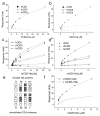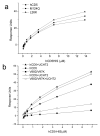A ligand for CD5 is CD5
- PMID: 20952682
- PMCID: PMC2996635
- DOI: 10.4049/jimmunol.0903823
A ligand for CD5 is CD5
Abstract
Recognition by scavenger receptor cysteine-rich domains on membrane proteins regulates innate and adaptive immune responses. Two receptors expressed primarily on T cells, CD5 and CD6, are linked genetically and are structurally similar, both containing three scavenger receptor cysteine-rich domains in their extracellular regions. A specific cell surface interaction for CD5 has been difficult to define at the molecular level because of the susceptibility of CD5 protein to denaturation. By using soluble CD5 purified at neutral pH to preserve biological activity, we show that CD5 mediates species-specific homophilic interactions. CD5 domain 1 only is involved in the interaction. CD5 mAbs that have functional effects in humans, rats, and mice block homophilic binding. Ag-specific responses by mouse T cells in vitro were increased when engagement of human CD5 domain 1 was inhibited by mutation or by IgG or Fab fragment from a CD5 mAb. This showed that homophilic binding results in productive engagement. Enhancement of polyclonal immune responses of rat lymph node cells by a Fab fragment from a CD5 mAb shown to block homophilic interactions provided evidence that the extracellular region of CD5 regulates inhibition in normal cells. These biochemical and in vitro functional assays provide evidence that the extracellular region of CD5 regulates immunity through species-specific homophilic interactions.
Figures




Similar articles
-
Interaction of recombinant and natural soluble CD5 forms with an alternative cell surface ligand.Eur J Immunol. 1999 Jul;29(7):2119-29. doi: 10.1002/(SICI)1521-4141(199907)29:07<2119::AID-IMMU2119>3.0.CO;2-F. Eur J Immunol. 1999. PMID: 10427974
-
The ectodomains of the lymphocyte scavenger receptors CD5 and CD6 interact with tegumental antigens from Echinococcus granulosus sensu lato and protect mice against secondary cystic echinococcosis.PLoS Negl Trop Dis. 2018 Nov 30;12(11):e0006891. doi: 10.1371/journal.pntd.0006891. eCollection 2018 Nov. PLoS Negl Trop Dis. 2018. PMID: 30500820 Free PMC article.
-
Structural analysis of the CD5 antigen--expression, disulphide bond analysis and physical characterisation of CD5 scavenger receptor superfamily domain 1.Eur J Biochem. 1998 Oct 1;257(1):131-41. doi: 10.1046/j.1432-1327.1998.2570131.x. Eur J Biochem. 1998. PMID: 9799111
-
Soluble CD5 and CD6: Lymphocytic Class I Scavenger Receptors as Immunotherapeutic Agents.Cells. 2020 Dec 3;9(12):2589. doi: 10.3390/cells9122589. Cells. 2020. PMID: 33287301 Free PMC article. Review.
-
CD6, a Rheostat-Type Signalosome That Tunes T Cell Activation.Front Immunol. 2018 Dec 18;9:2994. doi: 10.3389/fimmu.2018.02994. eCollection 2018. Front Immunol. 2018. PMID: 30619347 Free PMC article. Review.
Cited by
-
CD5-dependent CK2 activation pathway regulates threshold for T cell anergy.J Immunol. 2012 Sep 15;189(6):2918-30. doi: 10.4049/jimmunol.1200065. Epub 2012 Aug 17. J Immunol. 2012. PMID: 22904299 Free PMC article.
-
CD5 expression by dendritic cells directs T cell immunity and sustains immunotherapy responses.Science. 2023 Feb 17;379(6633):eabg2752. doi: 10.1126/science.abg2752. Epub 2023 Feb 17. Science. 2023. PMID: 36795805 Free PMC article.
-
Functional Heterogeneity in CD4(+) T Cell Responses Against a Bacterial Pathogen.Front Immunol. 2015 Dec 11;6:621. doi: 10.3389/fimmu.2015.00621. eCollection 2015. Front Immunol. 2015. PMID: 26697015 Free PMC article. Review.
-
Structures of CD6 and Its Ligand CD166 Give Insight into Their Interaction.Structure. 2015 Aug 4;23(8):1426-1436. doi: 10.1016/j.str.2015.05.019. Epub 2015 Jul 2. Structure. 2015. PMID: 26146185 Free PMC article.
-
T-cell modulatory properties of CD5 and its role in antitumor immune responses.Oncoimmunology. 2013 Jan 1;2(1):e22841. doi: 10.4161/onci.22841. Oncoimmunology. 2013. PMID: 23483035 Free PMC article.
References
-
- Aruffo A, Bowen MA, Patel DD, Haynes BF, Starling GC, Gebe JA, Bajorath J. CD6-ligand interactions: a paradigm for SRCR domain function? Immunol. Today. 1997;18:498–504. - PubMed
-
- Sarrias MR, Gronlund J, Padilla O, Madsen J, Holmskov U, Lozano F. The Scavenger Receptor Cysteine-Rich (SRCR) domain: an ancient and highly conserved protein module of the innate immune system. Crit. Rev. Immunol. 2004;24:1–37. - PubMed
-
- Bhandoola A, Bosselut R, Yu Q, Cowan ML, Feigenbaum L, Love PE, Singer A. CD5-mediated inhibition of TCR signaling during intrathymic selection and development does not require the CD5 extracellular domain. Eur. J. Immunol. 2002;32:1811–1817. - PubMed
-
- Pena-Rossi C, Zuckerman LA, Strong J, Kwan J, Ferris W, Chan S, Tarakhovsky A, Beyers AD, Killeen N. Negative regulation of CD4 lineage development and responses by CD5. J. Immunol. 1999;163:6494–6501. - PubMed
-
- Tarakhovsky A, Kanner SB, Hombach J, Ledbetter JA, Muller W, Killeen N, Rajewsky K. A role for CD5 in TCR-mediated signal transduction and thymocyte selection. Science. 1995;269:535–537. - PubMed
Publication types
MeSH terms
Substances
Grants and funding
LinkOut - more resources
Full Text Sources
Other Literature Sources
Miscellaneous

